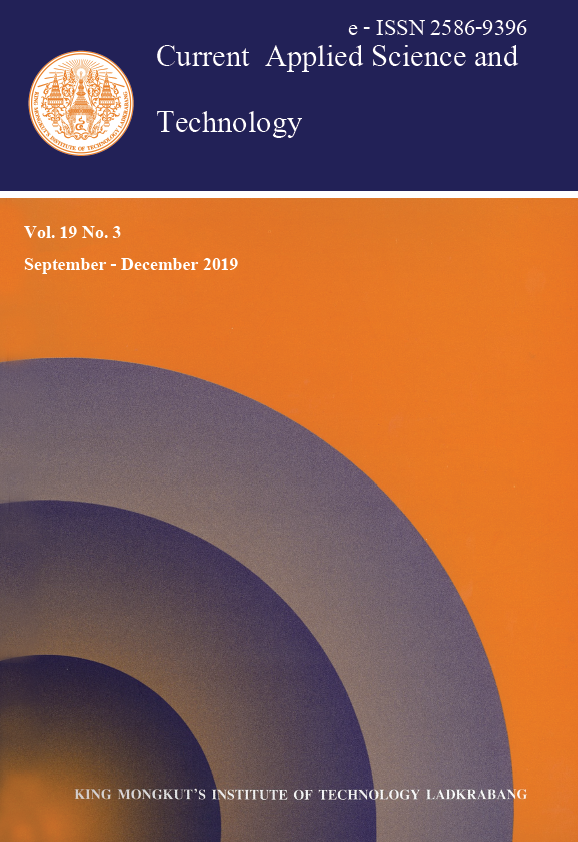Developing Stubble Chopper Device Adequate for Small Livestock Barns
Main Article Content
Abstract
The main objectives of this research are to develop a sustainable feeding unit in the small barns for daily fresh feed production by minimizing the operation cost of feed manufacturing and mixing the good soften cutter feed with nutrient supplements mechanically using an easy operating system. The storage of mixed fodder for a long period can expose its validity into rancidity and oxidation and reduces the nutritional value. Thus, an adequate feeding unit suitable for small barns is developed. Three experiments are conducted to test the developed unit on the variable levels of the cutting speeds (7.540, 9.426 and 11.304m/s), three feeding rates of (0.3, 0.6 and 0.9 ton/h) and three knife interferences of (5, 10 and 15 mm) to measure the performance rates, efficiency and economic evaluation. The results indicated that the maximum percentage in the soften cutting length > 5 cm was 92.82 % at the helical distribution with the maximum speed of 11.304 m/s, feeding rate of 0.9 ton/h and the largest knife interference of 15 mm. Besides, the maximum feed mixing efficiency (95.45 %) was recorded at the highest adaptable settings. Meanwhile, the maximum machine productivity was recorded at 0.85 ton/h at the same variables. Moreover, the maximum power consumption value (6.85 kWh/ton) was obtained at the lowest cutting speed of 7.540 m/s, feeding rate of 0.85 ton/h and knife interference of 5 mm. The maximum operation cost was 121.20 Egyptian pound/ton with the same factors.
Keywords: rancidity; oxidation; validity; cutting; mixing; feeding
*Corresponding author: E-mail: a.shawky71@yahoo.com
Article Details
Copyright Transfer Statement
The copyright of this article is transferred to Current Applied Science and Technology journal with effect if and when the article is accepted for publication. The copyright transfer covers the exclusive right to reproduce and distribute the article, including reprints, translations, photographic reproductions, electronic form (offline, online) or any other reproductions of similar nature.
The author warrants that this contribution is original and that he/she has full power to make this grant. The author signs for and accepts responsibility for releasing this material on behalf of any and all co-authors.
Here is the link for download: Copyright transfer form.pdf
References
Chenost, M. and Kayouli, C., 1997. Roughage utilisation in warm climates. FAO Animal Production and Health Paper 135, Rome
Church, D.C., 1991. Livestock Feeds and Feeding. 3rd ed. Englewood Cliffs: Prentice Hall.
Devendra, C., 1997. Crop residues for feeding animals in Asia: technology development and adoption in crop/livestock Systems. In: C. Renard, ed. Crop Residues in Sustainable Mixed Crop/Livestock Farming System. Wallingford: CAB International, pp. 241-267.
De Leeuw, P.N., 1997. Crop residues in tropical Africa : trends, in supply, demand and use. In : C. Renard, ed. Crop Residue in Sustainable Mixed Crop/Livestock Farming Systems. New York : CAB International.
Philip, D., Nkonya, E., Pender, J. and Oni, O.A., 2009. Constraints to increasing agricultural productivity in Nigeria: a review. NSSP Working Paper 6. Abuja: International Food Policy Research Institute (IFPRI).
Walli, T.K, Garg, M.R. and Makka, H.P.S., 2012. Crop Residue Based Densified Total Mixed Ration- A User friendly Approach to Utilise Food Crop By-products for Ruminant Production. FAO Animal Production and Health Paper No. 172, Rome.
Wanapat, M., Polyrach, S., Boonnop, K., Mapato, C. and Cherdthong, A., 2009. Effect of treating rice straw with urea and calcium hydroxide upon intake, digestibility, rumen fermentation and milk yield of dairy cows. Livestock Science, 125(2), 238-243.
Senthilkumar, S., Suganya, T., Deepa, K., Muralidharan, J. and Sasikala, K., 2016. Supplementation of molasses in livestock feed. International Journal of Science, Environment and Technology, 5(3), 1243-1250.
Akamittath, J.G., Brekke, C.J. and Schanus, E.G., 1990. Lipid oxidation and colour stability in restructured meat systems during frozen storage. Journal of Food Science, 55(10), 1513-1517.
Przybylski, R., and Eskin, N.A.M., 1995. Methods to measure volatile compounds and flavor significance of volatile compounds. In: K. Warner and N.A.M. Eskin, eds. Methods to Assess Oil Quality and Stability of Oils and Fat- Containing Foods. Champaign: AOCS Press, pp. 107-133.
Rawls, H.R. and Van Santen, P.J., 1990. A possible role for singlet oxygen in the initiation of fatty acid autoxidation. Journal of the American Oil Chemists’ Society, 47(1), 121-125.
Mathers, J.O. and Otchere, E.O., 2012. Research on the nutrition of working animals: needs, experiences and methods. FAO Document, p 9.
Hoque, M., Sokhansanj, S., Naimi, L., Bi X and Lim, J., 2007. Review and analysis of performance and productivity of size reduction equipment for fibrous materials. ASABE Paper Number: 076164. Paper presented at ASABE Annual International Meeting Minneapolis, Minnesota.
El-Berry, A.M., Baiomy, A., Radwan, H.A. and Arif, E.M., 2001. Evaluation of (Hematol) machine in rice straw chopping. 9th Conference of MISR Society of Agricultural Engineering, September 9-11, 2001, 65-76.
El-Iraqi, M. and El-Khawaga, S., 2003. Design and test performance of cutting machine for some crop residues. MISR Journal of Agricultural Engineering, 20(1), 85-101.
Abo-Habaga, M.M and Khader, M.O., 2005. Developed of a combined cutting unit with rice harvesting combine machine for utilization in field waste. Journal of Agricultural Science, 30(3), 1481-1487.
El-Hanfy, E.H. and Shalby, S.A., 2009. Performance evaluation and modification of the Japanese combine chopping unit. MISR Journal of Agricultural Engineering, 26(2), 1021- 1035.
Abo-Habaga, M.M., Yehia, I. and Abo-Elasaad, G.A., 2015. Development of a rice straw bales chopper. Journal of Soil Science and Agricultural Engineering, 6(10), 1249 -1262.
Hunt, D., 1983. Farm Power Machinery Management. 8th ed. Ames: Iowa State University Press.


